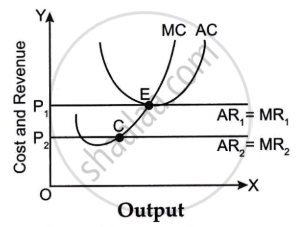Advertisements
Advertisements
Question
Explain with the help of Saving and Investment functions. Also, explain the changes that take place in an economy when the economy is not in equilibrium. Use diagram
Solution
Saving and Investment Approach
In the saving and investment approach, the equilibrium is attained at the point where saving and investment will intersect each other, i.e. leakages are equal to injections.

In the diagram, SS and II is the saving curve and investment curve, respectively. The II curve is a horizontal line which implies the autonomous investment. OQ is the equilibrium level of income where the SS and II curves intersect each other at Point E
Saving < investment on the left side of equilibrium point E: Investment exceeding saving implies that the injection into the circular flow of income is more than the withdrawal from the income. Supply of goods and services is not sufficient to meet the demand for goods and services. As consumption is high, there will be a low amount of saving and thereby planned output is not sufficient to meet the demand. This leads to a fall in the inventory, and therefore, the savings need to increase. This is possible only when the savings are again equal to the investment and the equilibrium is restored.
Saving > investment on the right side of equilibrium point E: Saving exceeding investment implies that the withdrawal from the income is more than the injection into the circular flow of income. Consumption of goods and services is less than the supply of goods and services. As saving is high, there will be low amounts of consumption and thereby the sold output is less than the planned output. This leads to accumulation of inventory, and therefore, the savings need to reduce. This is possible only when the savings are again equal to the investment and the equilibrium is restored.
APPEARS IN
RELATED QUESTIONS
When is an economy in equilibrium?
Answer the following question.
Give the meaning of under-employment equilibrium.
Which one of the following is the determining factor of Equilibrium Income in the Keynesian Viewpoint?
In Keynesian viewpoint, the equilibrium level of income and employment in the economy will be established where ______
Which of the following is a reason for surplus demand?
Refer to the diagram given below and choose the incorrect statement.

